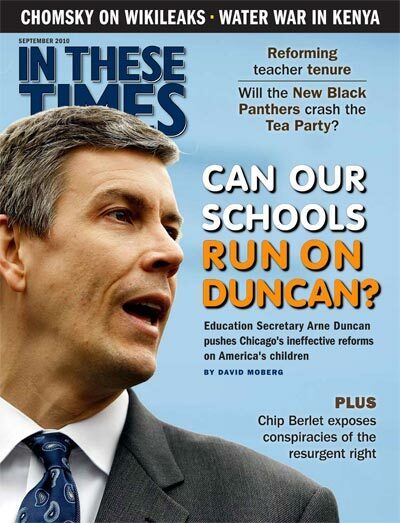Can Our Schools Run on Duncan?
Secretary of Education Arne Duncan pushes Chicago’s ineffective reforms on America’s children.
David Moberg

When President Barack Obama announced that his choice for Secretary of Education was Arne Duncan, chief executive of the Chicago Public Schools, he extolled his basketball buddy as a pragmatic, successful school reformer. “He’s not beholden to any one ideology,” Obama said, adding that Duncan would speak with authority based on “the lessons he’s learned during his years changing our schools from the bottom up.”
As a critic on the campaign trail of President George W. Bush’s No Child Left Behind Act, Obama implicitly offered Duncan’s efforts in Chicago as an alternative model of how his administration would improve American schools, particularly the most troubled.
But so far Duncan and Obama have only modified Bush’s education plans, retaining many problematic elements. The administration’s hallmark program, Race to the Top (RTTT), encourages states to adopt specified changes in a competition for money they desperately need. But it offers only $4.35 billion in the first two rounds for school systems that spend roughly $580 billion a year, $47 billion of which is federal aid. Yet by emphasizing this program, Duncan is pursuing dubious reforms that are not only likely to fail, but do real harm.
Obama claims that Duncan’s reform agenda is based on experience, but some of its key features remain untested – and those that have been tested have not worked well, if at all. Unfortunately, Duncan’s approach is rooted in an ideology that threatens America’s system of public education.
RTTT gives points to states if they meet specific requirements, doing the opposite of what Duncan says is the Obama administration’s objective – being tight on goals, loose on implementation. The policies Duncan urges states to implement in their quest for federal dollars include: expanding charter schools; linking teacher pay to student test scores; enabling districts to dismiss entire staffs of failing schools; weakening teacher tenure; and testing and tracking student performance even more stringently, albeit more comprehensively.
In late July, after a group of civil rights organizations faulted Obama for not proposing and funding an education strategy that aimed to help all students, Obama defended RTTT before the National Urban League as “the single most ambitious, meaningful education reform effort we’ve attempted in this country in generations.”
A dubious record
The track record of similar reform efforts in Chicago and across the nation, however, is too spotty to justify pushing them on every financially desperate school district.
Under pressure from Chicago’s school reform movement, in 1988 the state legislature devolved many responsibilities of the central administration to elected local school councils (LSCs) that hired principals and exercised modest budget authority. (I served on the LSC of Kenwood High School, which my children attended, as a parent representative between 1996 and 2000.) The councils worked well in about one-third of schools, satisfactorily in a third and poorly in another third. But in 1995, when the state of Illinois made Chicago’s mayor directly responsible for the schools, Mayor Richard M. Daley shifted power back to the central administration. Generally skeptical of government and a believer in the superiority of private business, Daley appointed superintendents – called “CEOs” – who identified with business groups like the Commercial Club, an elite business group that advocated corporate-style school management and a free-market education ideology.
Following a wave of magnet-school creation in the late ’90s, in 2001 Daley made Duncan CEO of Chicago schools. Duncan promoted charter schools and a controversial program known as “Renaissance 2010,” which involved shutting down poorly performing schools (mostly in black neighborhoods), dismissing all staff (including the lunch ladies), and reopening them, with or without the old student body.
Many of Duncan’s initiatives, and those like them, have not succeeded:
In the most definitive national study to date, Stanford University researchers reported last year that only 17 percent of charter schools outperformed traditional public schools in math, with 37 percent faring worse than public schools and 46 percent measuring up equally. Chicago’s charters (without tenure protection for their mostly nonunion teachers) have performed better in math, but no differently in reading, than public schools. Chicago’s public magnet schools – where teachers have tenure and a union, but students compete for admission – scored much higher in both math and reading.
Duncan’s much-touted RTTT encouragement of bonus payments to “good” teachers – to spur both teacher development and higher student test scores – had “no significant impact on student achievement or teacher retention” in Chicago, according to Mathematica Policy Research, a leading firm in assessing performance of social programs. (A study of a New York City merit-pay program also showed little effect on student performance.)
RTTT priorities also reflect Duncan’s Renaissance 2010 plan – close schools, then reopen them as small schools or charters – and his “portfolio strategy,” the school plan equivalent of an investment portfolio of private and public educational “assets.” But studies by SRI International and the Chicago Consortium on School Research (affiliated with the University of Chicago) concluded that Renaissance 2010 schools only occasionally performed better than demographically similar schools and that the portfolio strategy yielded “no dramatic improvements.”
Both Duncan and the Bush administration’s No Child Left Behind legislation encouraged increased reliance on standardized tests to measure student performance, thereby pressuring teachers to teach to the test so they and their students would “pass.” But strategies imposed on Chicago schools as a consequence for low scores – often against community and union protest – did not produce higher test scores, let alone better schools. Elementary school scores did rise sharply, but mostly because of a change in the test.
The number of high school students who failed to meet grade-level performance remained between 69 and 73 percent from 2001 to 2008, the year before Duncan left Chicago for Washington. In 2009, the Commercial Club concluded that despite “moderate” elementary school gains, after all of Duncan’s policy changes, the city’s high schools remained “abysmal” and students were not prepared for success in college or beyond.
There were certainly individual school success stories, some of which do not manifest themselves through improved test scores. Chicago Public Radio’s Linda Lutton has reported on the night-and-day difference in atmosphere between a Renaissance 2010 school and one not similarly transformed. Yet the practical results of the policies pushed by Duncan and Bush in the last decade, now put forward in slightly different form by Duncan and Obama, do not merit repetition.
Market-style myopia
Ultimately, the issue is: How well do the students learn. But important ideological issues are at stake as well, such as, what should education achieve?
This question is at the heart of a longstanding battle between business-oriented educators, who want to churn out a ready workforce, and progressive educators, acting in the tradition of John Dewey, who believe schools should nurture well-rounded, independent-minded citizens.
Unfortunately, most Republicans and many Democrats, including some progressives, believe that the problems with American schools can be solved with more market-style policies, competition, financial incentives, charter schools, privatization, standardized testing and weakened teachers’ unions.
But the theory that supports treating education as a marketplace is flawed, as is the practice. Richard Rothstein of the Economic Policy Institute and others point out that few professionals in the private sector are paid for performance (except in finance, and that should be a cautionary example). And when faced with performance incentives, people typically end up gaming the system. In a 2003 study, economists Steven Levitt of the University of Chicago and Brian Jacob of Harvard found that as high-stakes testing increased, teachers were more likely to cheat, for example, changing student answers, giving students correct answers and teaching from illicitly obtained advance test copies.
The educational systems in the rest of the developed world, which famously outperform U.S. schools, are overwhelmingly public, highly unionized and protected from market-style funding. Even though American suburban schools vary dramatically, many of these schools – with unions and teacher tenure – perform so well that affluent families pick their homes partly on the basis of school quality.
A Chicago Consortium on Schools Research team led by Anthony S. Bryk recently published Organizing Schools for Improvement: Lessons From Chicago, the result of two decades of study. They found that successful schools had five essential pillars of support: educational leadership, parent-community ties, professional capacity, a student-centered learning climate and instructional guidance. The stronger these pillars, the more the schools thrived and test results improved.
Rather than focus on building complex systems that extend beyond the school, market-oriented reformers tend to focus on one factor – teachers. (See Richard Greenwald’s “A Modest Proposal for Teacher Tenure Reform,” in ITT’s September 2010 issue.) Like most American managers, they see teachers, along with their unions, as a factor of production to be controlled, not as allies and resources for cooperation.
Americans across the political spectrum see education as a major solution to crime, inequality, unemployment and so on. But for decades, researchers have shown that the single most significant determining factor in students’ success in school is the socioeconomic status of their parents. (See Roger Bybee’s “It’s the Poverty, Stupid,” also in ITT’s September 2010 issue.)
That doesn’t mean poor students can’t learn. But their disadvantages – from untreated toothaches to constant transience of residence and school – can overwhelm even the best school.
What the children in America’s failing schools need is direct policy intervention to reduce inequality, to provide broader public services and to connect residents of very poor neighborhoods to jobs that pay a living wage.
What they are getting are Duncan’s questionable market-oriented reforms – reforms that often involve assaults on the public sector and organized labor. It’s a predictable shame when such nostrums are peddled by Republicans, a tragedy when embraced by Democrats.
David Moberg, a former senior editor of In These Times, was on staff with the magazine from when it began publishing in 1976 until his passing in July 2022. Before joining In These Times, he completed his work for a Ph.D. in anthropology at the University of Chicago and worked for Newsweek. He received fellowships from the John D. and Catherine T. MacArthur Foundation and the Nation Institute for research on the new global economy.









